Saturn’s Sponge-like Moon Hyperion By Europeanspaceagency On Flickr.
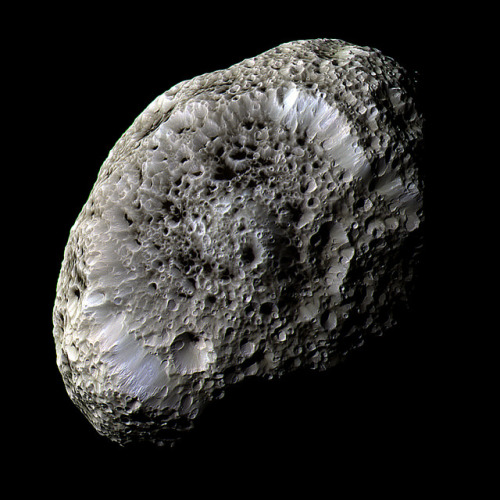
Saturn’s sponge-like moon Hyperion by europeanspaceagency on Flickr.
More Posts from The-sleepy-chemist and Others

This Week in Chemistry: Treating cataracts, LED preservatives, nitrogen glaciers, and more! http://goo.gl/56bcZu



Imperial Tortoise Beetle - Stolas imperialis
With only 6-12 mm in length, the Imperial Tortoise Beetle, Stolas imperialis (Coleoptera - Chrysomelidae), is truly astonishing by the intense blue color of its body and its elytral punctuation. This species, which is one of 181 that are grouped in the genus Stolas, is poorly known and only registered from Brazil.
References: [1] - [2] - [3]
Photo credit: ©Sergio Monteiro | Locality: Santa Catarina, Brazil (2014)
Largest Batch of Earth-size, Habitable Zone Planets
Our Spitzer Space Telescope has revealed the first known system of seven Earth-size planets around a single star. Three of these planets are firmly located in an area called the habitable zone, where liquid water is most likely to exist on a rocky planet.

This exoplanet system is called TRAPPIST-1, named for The Transiting Planets and Planetesimals Small Telescope (TRAPPIST) in Chile. In May 2016, researchers using TRAPPIST announced they had discovered three planets in the system.

Assisted by several ground-based telescopes, Spitzer confirmed the existence of two of these planets and discovered five additional ones, increasing the number of known planets in the system to seven.
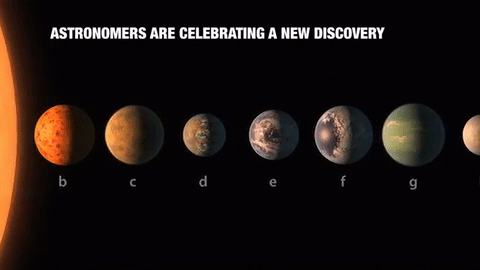
This is the FIRST time three terrestrial planets have been found in the habitable zone of a star, and this is the FIRST time we have been able to measure both the masses and the radius for habitable zone Earth-sized planets.
All of these seven planets could have liquid water, key to life as we know it, under the right atmospheric conditions, but the chances are highest with the three in the habitable zone.

At about 40 light-years (235 trillion miles) from Earth, the system of planets is relatively close to us, in the constellation Aquarius. Because they are located outside of our solar system, these planets are scientifically known as exoplanets. To clarify, exoplanets are planets outside our solar system that orbit a sun-like star.

In this animation, you can see the planets orbiting the star, with the green area representing the famous habitable zone, defined as the range of distance to the star for which an Earth-like planet is the most likely to harbor abundant liquid water on its surface. Planets e, f and g fall in the habitable zone of the star.
Using Spitzer data, the team precisely measured the sizes of the seven planets and developed first estimates of the masses of six of them. The mass of the seventh and farthest exoplanet has not yet been estimated.

For comparison…if our sun was the size of a basketball, the TRAPPIST-1 star would be the size of a golf ball.
Based on their densities, all of the TRAPPIST-1 planets are likely to be rocky. Further observations will not only help determine whether they are rich in water, but also possibly reveal whether any could have liquid water on their surfaces.
The sun at the center of this system is classified as an ultra-cool dwarf and is so cool that liquid water could survive on planets orbiting very close to it, closer than is possible on planets in our solar system. All seven of the TRAPPIST-1 planetary orbits are closer to their host star than Mercury is to our sun.

The planets also are very close to each other. How close? Well, if a person was standing on one of the planet’s surface, they could gaze up and potentially see geological features or clouds of neighboring worlds, which would sometimes appear larger than the moon in Earth’s sky.

The planets may also be tidally-locked to their star, which means the same side of the planet is always facing the star, therefore each side is either perpetual day or night. This could mean they have weather patterns totally unlike those on Earth, such as strong wind blowing from the day side to the night side, and extreme temperature changes.

Because most TRAPPIST-1 planets are likely to be rocky, and they are very close to one another, scientists view the Galilean moons of Jupiter – lo, Europa, Callisto, Ganymede – as good comparisons in our solar system. All of these moons are also tidally locked to Jupiter. The TRAPPIST-1 star is only slightly wider than Jupiter, yet much warmer.
How Did the Spitzer Space Telescope Detect this System?
Spitzer, an infrared telescope that trails Earth as it orbits the sun, was well-suited for studying TRAPPIST-1 because the star glows brightest in infrared light, whose wavelengths are longer than the eye can see. Spitzer is uniquely positioned in its orbit to observe enough crossing (aka transits) of the planets in front of the host star to reveal the complex architecture of the system.

Every time a planet passes by, or transits, a star, it blocks out some light. Spitzer measured the dips in light and based on how big the dip, you can determine the size of the planet. The timing of the transits tells you how long it takes for the planet to orbit the star.

The TRAPPIST-1 system provides one of the best opportunities in the next decade to study the atmospheres around Earth-size planets. Spitzer, Hubble and Kepler will help astronomers plan for follow-up studies using our upcoming James Webb Space Telescope, launching in 2018. With much greater sensitivity, Webb will be able to detect the chemical fingerprints of water, methane, oxygen, ozone and other components of a planet’s atmosphere.
At 40 light-years away, humans won’t be visiting this system in person anytime soon…that said…this poster can help us imagine what it would be like:

Make sure to follow us on Tumblr for your regular dose of space: http://nasa.tumblr.com




Next week I’ll give a presentation on the Researchers Night at Eötvös Loránd University, Hungary with the title: “Chemistry of light and the light of chemistry”.
During this presentation one of my favorite dyes will be also presented: Nile Red. However, just as usual, the 1000 USD/gram price was a bit over our budget, so I had to make it.
The raw product was contaminated with a few impurities, but a fast purification, by simple filtering the mixture through a short column helped a lot and ended up with a +95% pure product.
At first I concentrated the product from a dilute solution on the column as seen on the first pics. It’s interesting to see, that it has a different fluorescence in solution (faint orange fluorescent) and while it’s absorbed on the solid phase (pink, highly fluorescent).
After all the product was on the solid phase, I added another solvent and washed down the pure, HIGHLY FLUORESCENT product. Everything else, what was mainly products of side reactions, stuck at the top of the column as seen on the second pics and the gifs.
Also here is a video from the whole process in HD: https://youtu.be/W0Lk5jkd_B0
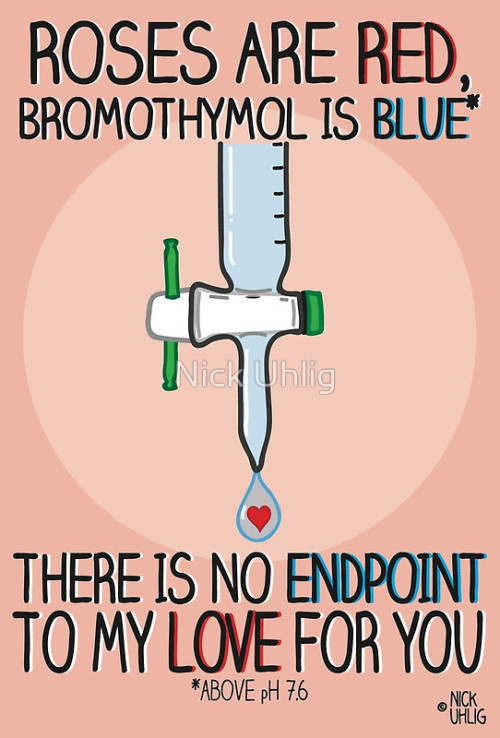
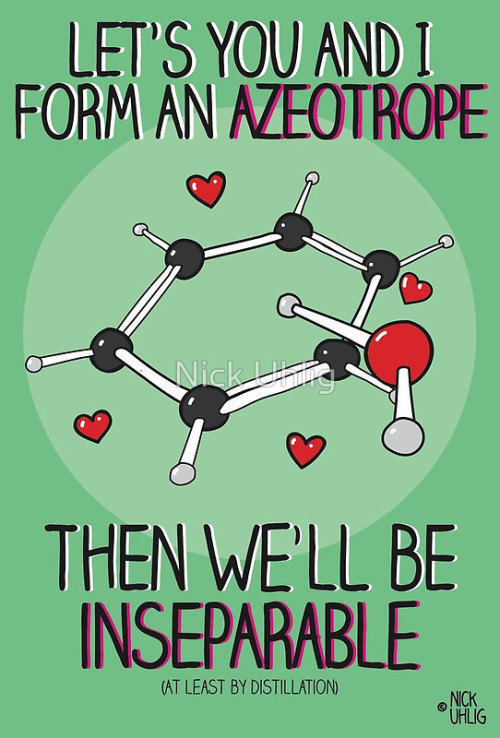
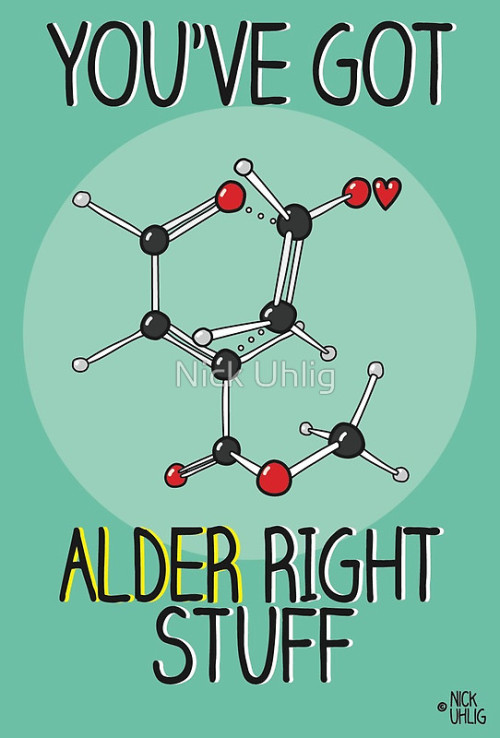

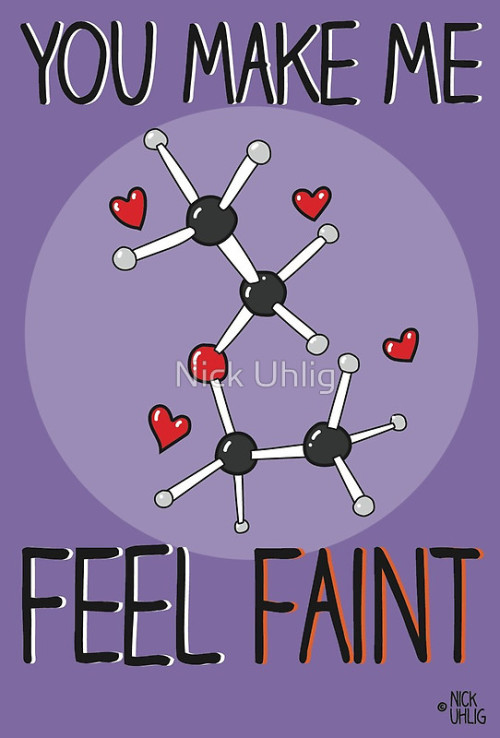

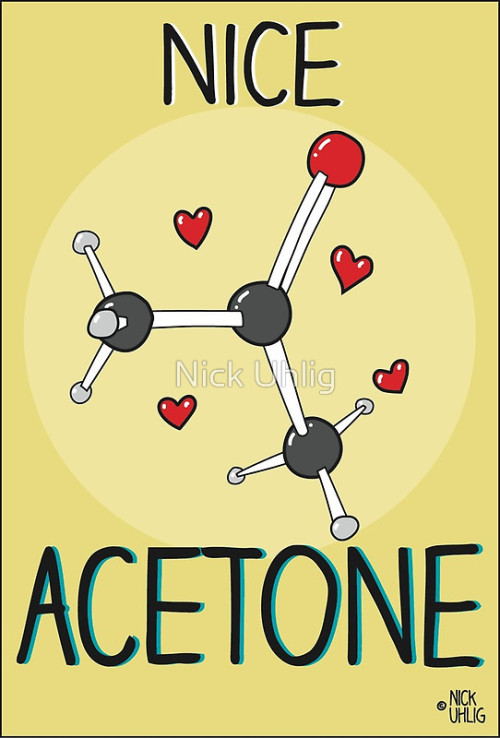
Chemistry Valentine’s Cards by Nick Uhlig.

Nothing can stop us!

On military live fire training ranges, troops practice firing artillery shells, drop bombs on old tanks or derelict buildings and test the capacity of new weapons.
But those explosives and munitions leave behind toxic compounds that have contaminated millions of acres of U.S. military bases – with an estimated cleanup bill ranging between $16 billion and $165 billion.
In a paper published online Nov. 16 in Plant Biotechnology Journal, University of Washington and University of York researchers describe new transgenic grass species that can neutralize and eradicate RDX – a toxic compound that has been widely used in explosives since World War II.
UW engineers introduced two genes from bacteria that learned to eat RDX and break it down into harmless components in two perennial grass species: switchgrass (Panicum virgatum) and creeping bentgrass (Agrostis stolonifera). The best-performing strains removed all the RDX from a simulated soil in which they were grown within less than two weeks, and they retained none of the toxic chemical in their leaves or stems.
Continue Reading.

COFFEE STAIN UNDER A MICROSCOPE
Vin Kitayama, an artist and environmental researcher, created this image from something fairly mundane: an evaporating drop of espresso. Kitayama placed the drop on a microscope slide and then snapped pictures through a polarized light microscope at 4× magnification. As the coffee dried, solid compounds that were dissolved in the coffee, such as caffeine and chlorogenic acid, started forming small crystals. In the polarized light, these crystals shimmered different colors. The image won 9th place in the Nikon Small World photomicrography competition.
Credit: Vin Kitayama
More Chemistry in Pictures and C&EN content:
U.S. Senators Push for Ban on Caffeine Powder
Caffeinated Cocrystals
Tweaking Coffee’s Flavor Chemistry




Cyanea capillata by Alexander Semenov
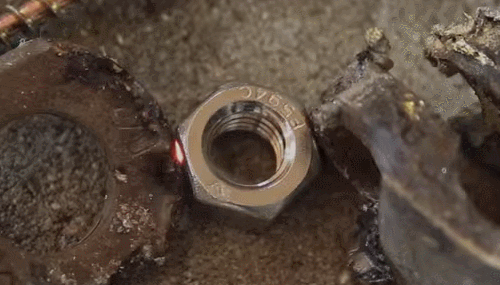
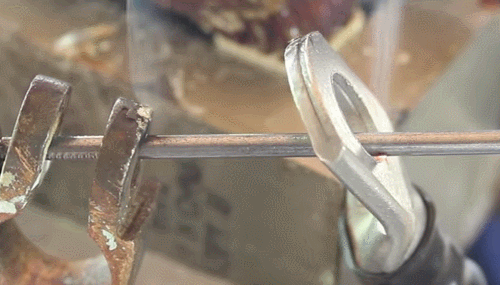
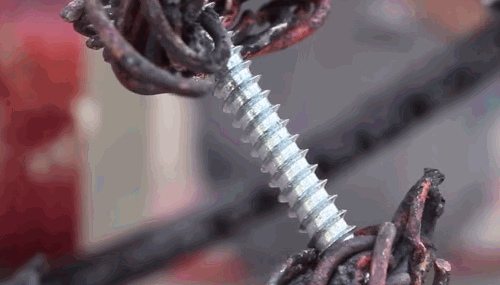
High Current/Amps through metal
Any metal that can conduct low voltage / high amperage electricity acts as a resistor between two electrode wires (as in the case above), which are made out of copper, which has a better conductivity than iron/steel which heats up due to the extreme electrical resistance.
Copper (Cu):
Resistivity: ρ(Ω·m) at 20ºC = 1.68×10−8
Conductivity: σ (S/m) at 20ºC = 5.96×107
Temp. Coefficient: 0.003862 (K−1)
Iron (Fe): (although what you see in the gif is steel, iron comes pretty close)
Resistivity: ρ(Ω m) at 20ºC = 1.00×10−7
Conductivity: σ (S/m) at 20ºC = 1.00×107
Temp. Coefficient: 0.005 (K−1)
Giffed by: rudescience From: This video
-
 therandomninjakitty liked this · 9 years ago
therandomninjakitty liked this · 9 years ago -
 tilonom reblogged this · 9 years ago
tilonom reblogged this · 9 years ago -
 minidrames liked this · 10 years ago
minidrames liked this · 10 years ago -
 humanbyweight liked this · 10 years ago
humanbyweight liked this · 10 years ago -
 jordanush liked this · 10 years ago
jordanush liked this · 10 years ago -
 felixios reblogged this · 10 years ago
felixios reblogged this · 10 years ago -
 felixios liked this · 10 years ago
felixios liked this · 10 years ago -
 katknr liked this · 10 years ago
katknr liked this · 10 years ago -
 tysoniansaganist reblogged this · 10 years ago
tysoniansaganist reblogged this · 10 years ago -
 amedrano133-blog-blog liked this · 10 years ago
amedrano133-blog-blog liked this · 10 years ago -
 alucrrd reblogged this · 10 years ago
alucrrd reblogged this · 10 years ago -
 youknow08081 liked this · 10 years ago
youknow08081 liked this · 10 years ago -
 amendoasradioativas reblogged this · 10 years ago
amendoasradioativas reblogged this · 10 years ago -
 star-burst-and-pixie-dust reblogged this · 10 years ago
star-burst-and-pixie-dust reblogged this · 10 years ago -
 picprens27-blog liked this · 10 years ago
picprens27-blog liked this · 10 years ago -
 m4rkh liked this · 10 years ago
m4rkh liked this · 10 years ago -
 vitamini liked this · 10 years ago
vitamini liked this · 10 years ago -
 allymay777 liked this · 10 years ago
allymay777 liked this · 10 years ago -
 jedimasterian reblogged this · 10 years ago
jedimasterian reblogged this · 10 years ago -
 fight-a-losing-war liked this · 10 years ago
fight-a-losing-war liked this · 10 years ago -
 zanganocochino liked this · 10 years ago
zanganocochino liked this · 10 years ago -
 4dvant reblogged this · 10 years ago
4dvant reblogged this · 10 years ago -
 5moremonths reblogged this · 10 years ago
5moremonths reblogged this · 10 years ago -
 5moremonths liked this · 10 years ago
5moremonths liked this · 10 years ago -
 veetlejuiced reblogged this · 10 years ago
veetlejuiced reblogged this · 10 years ago -
 across-an-infinite--universe reblogged this · 10 years ago
across-an-infinite--universe reblogged this · 10 years ago -
 voodooeyez reblogged this · 10 years ago
voodooeyez reblogged this · 10 years ago -
 orderme reblogged this · 10 years ago
orderme reblogged this · 10 years ago -
 idonotliketheconeofshamesblog reblogged this · 10 years ago
idonotliketheconeofshamesblog reblogged this · 10 years ago -
 idonotliketheconeofshamesblog liked this · 10 years ago
idonotliketheconeofshamesblog liked this · 10 years ago -
 j-t-mack reblogged this · 10 years ago
j-t-mack reblogged this · 10 years ago -
 wussy-pussy-blog liked this · 10 years ago
wussy-pussy-blog liked this · 10 years ago -
 thegirldownthelaine liked this · 10 years ago
thegirldownthelaine liked this · 10 years ago -
 lea-lolly liked this · 10 years ago
lea-lolly liked this · 10 years ago -
 angeliquelle liked this · 10 years ago
angeliquelle liked this · 10 years ago -
 skellietor reblogged this · 10 years ago
skellietor reblogged this · 10 years ago -
 leprintemps reblogged this · 10 years ago
leprintemps reblogged this · 10 years ago
60 posts